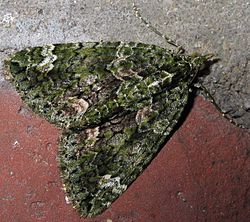Chloroclysta
| Den här artikeln har skapats av Lsjbot, ett program (en robot) för automatisk redigering. (2013-06) Artikeln kan innehålla fakta- eller språkfel, eller ett märkligt urval av fakta, källor eller bilder. Mallen kan avlägsnas efter en kontroll av innehållet (vidare information) |
| Chloroclysta | |
 | |
| Systematik | |
|---|---|
| Domän | Eukaryoter Eukaryota |
| Rike | Djur Animalia |
| Stam | Leddjur Arthropoda |
| Understam | Sexfotingar Hexapoda |
| Klass | Egentliga insekter Insecta |
| Ordning | Fjärilar Lepidoptera |
| Överfamilj | Geometroidea |
| Familj | Mätare Geometridae |
| Släkte | Chloroclysta |
| Vetenskapligt namn | |
| § Chloroclysta | |
| Auktor | Hübner, 1825 |
| Hitta fler artiklar om djur med | |
Chloroclysta[1] är ett släkte av fjärilar som beskrevs av Jacob Hübner 1825. Chloroclysta ingår i familjen mätare.[1][2]
Kladogram enligt Catalogue of Life[1] och Dyntaxa[2]:
| Chloroclysta |
| |||||||||||||||||||||||||||||||||||||||||||||||||||||||||||||||||||||
Bildgalleri
Källor
- ^ [a b c] Bisby F.A., Roskov Y.R., Orrell T.M., Nicolson D., Paglinawan L.E., Bailly N., Kirk P.M., Bourgoin T., Baillargeon G., Ouvrard D. (red.) (27 januari 2011). ”Species 2000 & ITIS Catalogue of Life: 2011 Annual Checklist.”. Species 2000: Reading, UK. http://www.catalogueoflife.org/annual-checklist/2011/search/all/key/chloroclysta/match/1. Läst 24 september 2012.
- ^ [a b] Dyntaxa Chloroclysta
Externa länkar
 Wikimedia Commons har media som rör Chloroclysta.
Wikimedia Commons har media som rör Chloroclysta. Wikispecies har information om Chloroclysta.
Wikispecies har information om Chloroclysta.
|
Media som används på denna webbplats
Robot icon
Författare/Upphovsman: Notafly, Licens: CC BY-SA 3.0
Dysstroma truncata (Hufnagel, 1767) larva Co. Antrim Ireland
Författare/Upphovsman: Notafly, Licens: CC BY-SA 3.0
Chloroclysta truncata larva Co. Antrim Ireland.The hairless larva is green with a pink stripe, a perfect match for the strawberry leaf petioles.The caterpillar is curved head up,claspers down. Earlier it was in a loop resembling an unfurling petiole. See a more distant view hereFile:ChloroclystaTruncataLarva (3).jpg
Note Protective resemblance. Geometrid caterpillars do proceed in by looping their slender bodies. Caterpillars of moths in most other families have five pairs of false legs or claspers, in Geometridae there are two pairs, which are close together at the end of the body. When the caterpillars moves, it clings very firmly by the six true legs on the segments close to the headand loosening the grasp of the claspers at the hind end.The claspers are then drawn close to the true legs,arching the body between into a loop. The claspers are then grip tightly to the stem on which the caterpillar is moving, and the body is straightened again so as to find a fresh foothold for the true legs.The movement is smoot and can be fast.
Many geometrid caterpillars spend much time stretched out at full length with the body motionless and rigid and at an angle to the twig or leaf looking like a short or broken twig. Their skins are not hairy and the colours (variously brown,yellow, green and grey) resemble the food plant . Some are have bud-like knobs or scars like bud scars, others are withered or furrowed like the bark of branches or twigsFörfattare/Upphovsman: Notafly, Licens: CC BY-SA 3.0
Dysstroma truncata (Hufnagel, 1767) larva Co. Antrim Ireland






